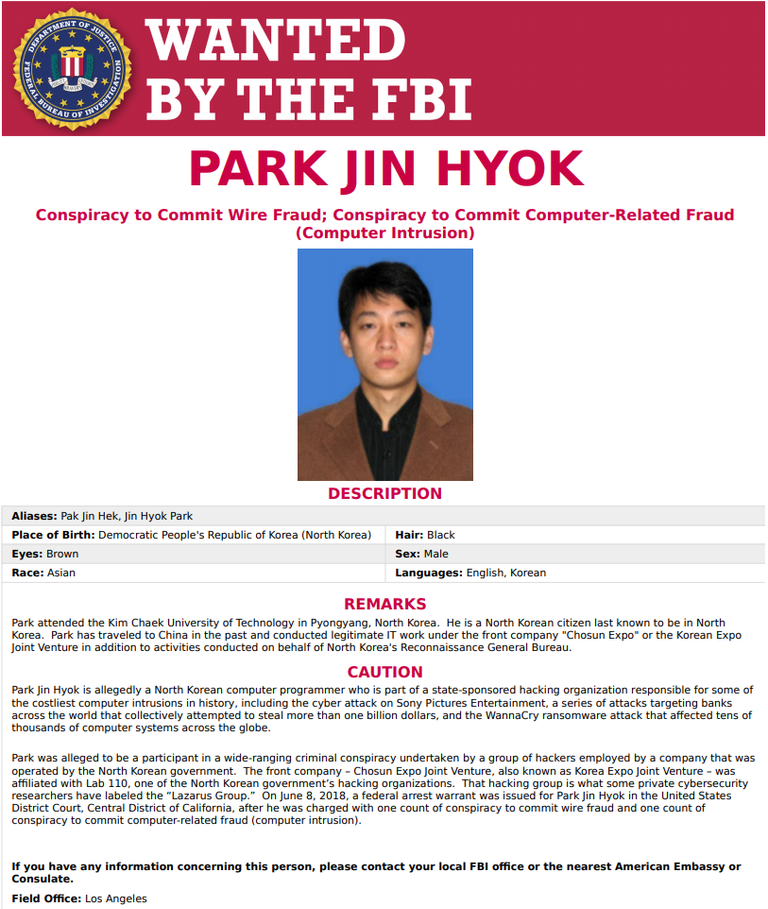The Lazarus Group, also known as Guardians of Peace or Whois Team, is a notorious hacker collective linked to numerous high-profile cyberattacks. While commonly attributed to North Korea, the true origins and composition of this group remain a subject of debate among cybersecurity experts.
 Park Jin Hyok, One of the Hackers of Lazarus Hacking Group
Park Jin Hyok, One of the Hackers of Lazarus Hacking Group
Origins and Attribution
The Lazarus Group first gained widespread attention in 2014 with the Sony Pictures hack. Since then, they have been implicated in numerous cyberattacks targeting various industries, particularly financial institutions and cryptocurrency exchanges. However, concrete evidence directly linking Lazarus to the North Korean government remains limited. Some experts suggest alternative theories:
- Cyber-mercenary collective: The group could be working for various clients, including but not limited to North Korea.
- Chinese involvement: Some members might be operating from China, particularly the city of Shenyang.
- False flag operations: Other state or non-state actors might be using North Korea as a cover to deflect attention from their true identities. False flag operations are designed to impersonate or use the distinctive infrastructure, tactics, techniques, or procedures of another threat actor[5].
- Western intelligence agencies: There are claims that Western governments or intelligence agencies, such as the CIA, have conducted harmful cyber operations and could potentially be involved in or mimicking the activities attributed to Lazarus[4].
Suspected Hacking Incidents
Some notable attacks attributed to the Lazarus Group include:
- 2014 Sony Pictures hack
- 2016 Bangladesh Bank heist ($81 million stolen)
- 2017 WannaCry ransomware attack
- Multiple cryptocurrency exchange hacks (e.g., Bithumb, Youbit)
- 2019 attacks on financial institutions, including a $49 million theft from a Kuwaiti institution
Hacking Patterns and Techniques
The Lazarus Group is known for its sophisticated and evolving tactics:
- Social engineering: Often the initial point of entry, using phishing emails or fake job offers.
- Custom malware: Development and deployment of tailored malicious software like MagicRAT and QuiteRAT[1].
- Exploitation of zero-day vulnerabilities
- Cryptocurrency theft: Targeting exchanges and users with specialized malware.
- Long-term persistence: Maintaining access to compromised networks for extended periods.

Mitigation Strategies
To protect against Lazarus Group-style attacks:
- Employee training: Focus on recognizing social engineering attempts.
- Robust endpoint security: Deploy solutions capable of detecting and blocking custom malware.
- Multi-factor authentication (MFA): Implement across all systems to prevent unauthorized access.
- Regular patching: Promptly apply security updates to prevent exploitation of known vulnerabilities.
- Zero-trust security model: Implement strict access controls and authenticate each request individually.
- Cryptocurrency security: For exchanges and users, employ cold storage and enhanced transaction verification processes.
While the Lazarus Group is commonly associated with North Korea, it's crucial to approach this attribution with caution. The complex nature of cybercrime makes definitive identification challenging, and the true composition of groups like Lazarus may be more nuanced than initially assumed.
There is also the possibility that other state or non-state actors, including Western intelligence agencies, could be involved in or mimicking the activities attributed to Lazarus. This highlights the importance of not making biased decisions without clear evidence.
For those involved in cryptocurrency and financial technology, staying informed about the evolving tactics of threat actors like the Lazarus Group is essential. Implementing robust security measures and maintaining a skeptical approach to unsolicited communications can significantly reduce the risk of falling victim to such sophisticated cyber threats.
Remember, in the world of cybersecurity, attribution is often based on circumstantial evidence and patterns rather than irrefutable proof. As our understanding of these hacking collectives evolves, so too must our strategies for defending against them.
오 해킹을 위해서 단순 컴퓨터 스킬이 아니라 사회공학까지 이용하다니... 조심해야 겠네요... ㄷㄷㄷ
그러게요... 단순 프로그래밍에 더해, 사람의 심리까지 연구하고 이용하니까 항상 조심해야겠다는 생각을 많이합니다.
어떻게 보면, 미래의 어두운 부분의 일면의 시작인가 싶기도 하구요.
사람의 심리를 이용한다는 면에서는, 숙련된 트레이더와 비슷한 면도 있는것 같습니다.
It's scary how advanced these hackers are. Makes you wonder who is really behind it all. Stay safe out there good friend
Stay safe, Bro. There may be lots of unknown or hard-to-expect skills or strategies of hacking. We should be cautious and careful to protect our assets and privacy.